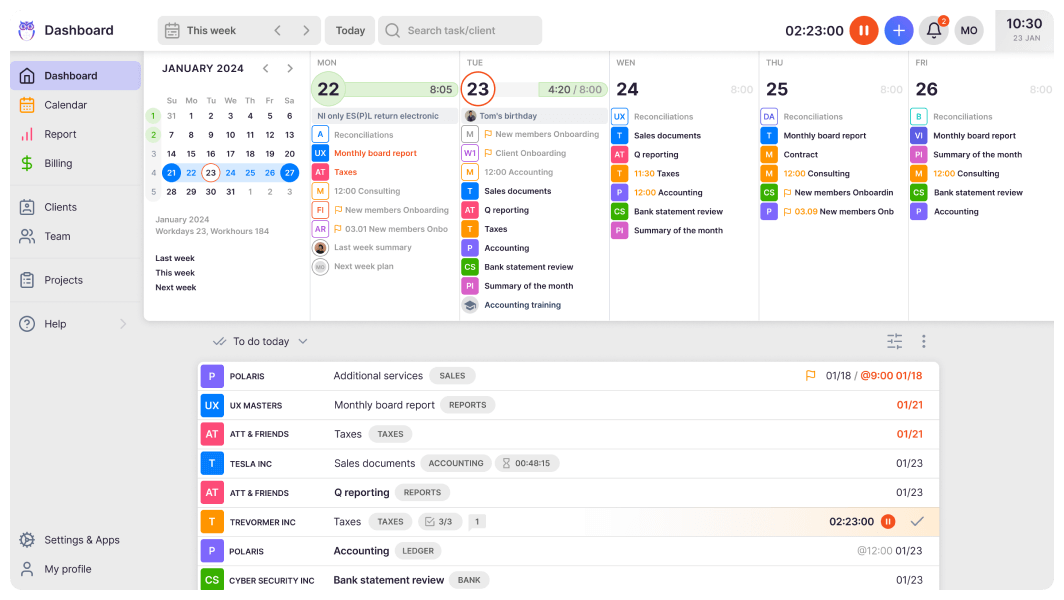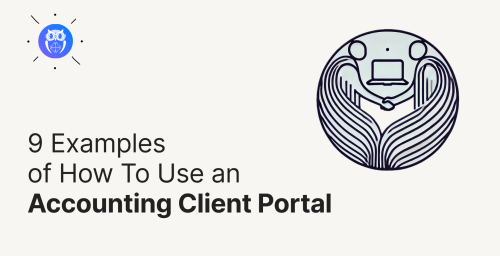Communication keeps a business running efficiently. This is especially true when dealing with clients. While it can be tricky for accounting firms with customers with varying levels of experience dealing with complex financial terms and computations, it can be well worth the effort.
Companies that prioritize customer experience (CX) can drive profitable growth. McKinsey’s analysis revealed that between 2016 and 2021, companies that proactively improved CX through communication and other methods doubled their revenue compared to competitors.
Why does client communication matter?
A repeat or existing customer is 67% more likely to spend on a business’s services, accounting for a significant chunk of annual revenue. A strong client communication strategy contributes to the experience of converting new customers into repeat customers.
When accountants have excellent communication skills, they gain the customers’ trust, effectively raising client satisfaction, encouraging them to stay loyal to the firm, and increasing the chances of them vouching for the firm and referring new clients. Laying down the groundwork for effective client communication allows you to see long-term business success.
5 pillars of client communication
When building a client communication strategy, factor in every point of contact, both written and verbal. These pillars of communication will help steer your messaging in the right direction.
1. Clarity
Some financial concepts may be confusing from a client’s perspective if they have minimal experience with finance. Writing in a clear voice with simple terms can make it easier for them to understand.
The best way to do this is to elaborate on concepts in layman’s terms during client interactions, avoiding industry jargon.
2. Consistency
What a client might perceive as poor communication may be inconsistent in how often you can reach out or converse with them. This can frustrate a client as the firm or accountant’s availability can appear uncertain.
Establish an explicit schedule for regular check-ins to facilitate consistent and effective communication.
3. Transparency
Shedding light on all the essential factors a client needs to know, such as pricing, deadlines, and potential financial risks, allows them to feel valued and cared for. Have upfront conversations about critical information and inform them of any changes to ensure a mutual understanding of the agreement’s outcomes.
4. Responsiveness
Like staying consistent, ensuring you respond promptly can strengthen your business relationship and demonstrate the firm’s reliability and commitment to the craft. You can set a response time policy for day-to-day communication, such as a 24-hour response, implementing automated acknowledgement messages, and escalating urgent requests.
5. Empathy
Part of gaining your client’s trust is making sure they feel understood. According to McKinsey’s research, 76% of consumers expect a more personalized experience from brands they engage with.
Active listening and taking cues from conversations to address concerns, like offering support in economic downturns, can forge a more personal relationship to positively impact customer retention.
Client communication best practices for accounting firms
Great client communication goes beyond delivering a clear message during the first interaction. How you provide and respond to each piece of information and how you listen to and act on client feedback can affect how they perceive your business.
1. Listen and ask questions
From the pillar of empathy, actively listening to your client’s needs and concerns can help you determine what kind of support they need from your firm. During every meeting, ask open-ended questions so clients can elaborate on their thoughts.
This also opens up the opportunity to speak with them personally, since you can open the floor for more casual voicing of opinions. This can make it easier to identify deeper objectives and challenges that may not come to light in the first conversation.
Tip: When dealing with clients in niche businesses, ask follow-up questions to gain insight into the business and what makes its owner tick.
2. Provide educational content
Again, communication in accounting can be tricky because of the complex concepts that most people may not be used to. Not all accounting firms educate clients on financial concepts and jargon.
Taking the next best step of providing context with educational material that explains what might appear overwhelming can help them make an informed decision.
You can also create your resources, such as newsletters and webinars, or share articles. Personalize it by sending educational content related to your client’s priorities, concerns, and industries. This can position your firm as a valuable resource against competitors.
Tip: When creating educational content, explore new ways to keep the resource engaging and easily digestible.
3. Be proactive with updates
Anticipating what your client needs is key to keeping them happy. When ironing out your project management efforts, don’t wait for clients to ask for updates; as soon as you recognise that there is information or updates they need to know, share them as soon as possible.
This promotes transparency and helps manage expectations that can prevent issues. This includes factors like changes in deadlines, regulatory changes relevant to their industry, and other financial repercussions.
Using tools such as SMS call center software can streamline communication, ensuring clients receive timely updates through their preferred channels.
Tip: A heads-up on sudden changes builds trust. Always provide context in your update and give them a better understanding.
4. Maximize technology to enhance communication
Leveraging new technology streamlines processes and improves the client experience. Many client communication tools in the market use the latest technology, like cloud-based data storage and artificial intelligence (AI) powered support for efficient and more transparent customer interactions.
Salesforce data found that 42% more consumers used chatbots for online retail shopping during the 2024 holidays than the previous year. This does indicate that there is room for businesses, even in the finance industry, to improve client communication with tech like AI to streamline processes for small things like identifying the services they need.
Tip: Use AI chatbots to handle standard client queries, document requests, and invoice statuses.
You can also implement AI for data analysis so you can proactively identify recommendations for each customer.
5. Use secure communication channels
There are many ways to communicate with your client. Providing them with a range of options offers flexibility, whether through text messaging, emails or calls over the Internet. What’s important, however, is protecting client data. Using secure channels ensures confidentiality and compliance with regulations.
Accounting firms hold a wealth of sensitive information for every customer in the database. Implementing secure and end-to-end encrypted client portals and messaging apps is imperative to protect any uploaded document and stored information from leaking.
Tip: Implement multi-factor authentication (MFA) for your customers to add an extra layer of protection before accessing data to minimize data breaches.
6. Stay in touch even during the off-season
Reach out to your client even during the off-season to keep your firm top-of-mind for your services so that they’ll come to your firm when tax deadlines and financial statements are due.
Quarterly financial newsletters can help establish you as a trustworthy and credible advisor against competition. You can also hold Q&A sessions online or in person to showcase your firm’s expertise.
Common challenges in client communication in accounting and how to overcome them
Poor client communication can earn negative feedback and affect prospective customers’ perception of your firm. Safeguard your brand image by knowing the most common challenges when dealing with clients and how to overcome them.
Clients are not responding to communication
It’s no surprise that progress is delayed because clients don’t respond, miss emails, or forget to submit documents crucial to their tax filing, statement, and other concerns.
How to overcome:
- Explicitly state response deadlines for both parties in initial agreements to get a mutual understanding of what’s expected from the firm and your client.
- Automate reminders for deadlines and follow-ups via their preferred communication channel.
Setting and managing expectations
There will always be clients who want faster timelines or services. Sometimes, the scope of work they expect can exceed what’s initially agreed upon. It’s essential to manage their expectations in clear writing.
How to overcome:
- Always kick things off by defining deliverables, deadlines, and responsibilities in engagement letters for reference.
- Provide client portals where they can find resources they need and track their service status anytime.
Overcommunication leading to client overwhelm
While client communication requires much information to be shared occasionally, sending too many messages or updates can overwhelm them. This can be frustrating and lead a client to unsubscribe or disengage with your content.
How to overcome:
- Set and follow through with an established communication cadence. Allow your client to decide the frequency you can reach out, whether weekly, biweekly, or monthly.
- To keep it easy to understand, summarise key points in concise reports or dashboards.
Prioritizing communication with clients can lead your firm to long-term success. By keeping the five pillars of communication in mind, you’ll have no problem adapting best practices that suit your firm’s processes, whether AI chatbots, personalized messaging, or proactive updates. All this can lead to better client retention and more referrals to position your firm for sustainable growth.



















